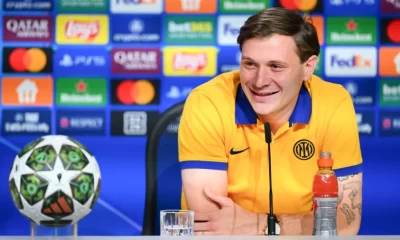Travel
Icon of the Seas: Can the world’s biggest cruise ship really be environmentally friendly?
Five times larger than the Titanic with room to spare, the Icon of the Seas can carry 7,600 passengers.
The world’s biggest cruise ship is about to embark on its first sailing. On 27 January, the Icon of the Seas will depart on its inaugural cruise
The Icon of the Seas is longer than the Eiffel Tower is tall with 20 decks. There are seven pools including the “largest pool at sea” as well as a waterpark with six waterslides. The ship has more than 40 bars and restaurants spread across eight “neighbourhoods”.
Five times larger than the Titanic, it has a maximum capacity of 7,600 passengers and more than 2,000 crew.
The ship’s first sailing has already sold out and trips through the rest of 2024 are fast filling up. It is one of 14 new cruise ships setting sail this year alone.
With features like liquefied natural gas (LNG) powered engines, heat from the engines used to warm water, and the ability to plug into electricity supplies at ports, Icon of the Seas will be Royal Caribbean’s “most sustainable ship to date”, according to the company.
And cruise ships are only getting bigger with the average liner growing by 10,000 gross tonnes every decade. Some are concerned about the environmental consequences of such increasingly massive vessels.
So do bigger cruise ships really mean a bigger impact on the climate?
How do cruises impact the environment?
The launch of Icon of the Seas comes as many European countries crack down on cruise ships with new regulations aimed at targeting pollution in ports.
Tough new rules in Norway will mean that only ships powered by alternative fuels can dock in the country’s harbours from 2026. The government is trying to cut down on pollution in its scenic fjords caused by the marine diesel that many cruise liners run on.
Espen Barth Eide, Norway’s foreign minister, told German broadcaster DW that cruise ships “cause the world’s highest emissions per passenger and travel kilometre”.
So just how carbon-intensive is the average cruise? The most efficient cruise ships emit around 250g of CO2 per passenger kilometre, according to estimates by the International Council on Clean Transportation (ICCT).
Using the same methodology the carbon intensity of a short-haul flight is around 110g of CO2 per passenger kilometre.
ICCT tallied up the emissions for a five-night 2,000-kilometre trip in the US on the most efficient cruise line and compared it to a round-trip flight and same length stay in a hotel.
The person taking the cruise would generate about double the amount of total greenhouse gases of the person taking a flight, it found – and that’s without considering that many people fly to get to their departure port.
Are alternative fuels a solution?
The newest cruise ships are increasingly fuelled by liquified natural gas (LNG) with the aim of cutting carbon emissions.
Burning LNG releases less nitrous oxide, sulphur oxide and particulate pollution than traditional fuels – a main concern for ports across the world where ships sit idling for hours on end. With around 25 per cent less carbon dioxide too, cruise operators say it is a ‘climate-friendly’ alternative.
The Icon of the Seas is just one of a number of new ships with dual-fuel engines that can run on both marine diesel and LNG. It is the operator Royal Caribbean’s first ship to be powered by this fuel.
But there are concerns about potential methane leaks from the type of engines that these cruise ships use. This extremely potent greenhouse gas has climate impacts more than 80 times greater than CO2 over 20 years.
While ships burning LNG may emit less carbon dioxide than traditional marine fuels, they often fail to burn all of this invisible gas. Nearly 80 per cent of ships that burn LNG use a type of engine that leaks 3.1 per cent of its fuel into the atmosphere, according to Transport & Environment.
Research from the Brussels-based nonprofit claims this could be worse for the climate in the short term than burning traditional fuels.
Royal Caribbean says LNG was the most viable alternative when the Icon of the Seas was being designed 10 years ago. Next year it is preparing to debut the Celebrity Xcel – a 3,248-passenger ship with a tri-fuel engine that can also run on methanol. And the company claims it has built the Icon of the Seas to make it adaptable to other fuel sources like methanol in the future.
The maritime industry sees this as one of the most promising alternative fuels in the near future.
Though newer ships with less leaky engines and forward-thinking solutions are on the way, the average cruise ship currently sailing the world’s seas is now more than 22 years old.
Environmental groups argue that many that are being built today will likely still be in service by 2050 when the International Maritime Organisation (IMO) aims to reach its net-zero target.
Travel
Wildfire warnings issued in the Canary Islands as millions prepare to holiday there
ADVERTISEMENT
As millions of holidaymakers prepare to head to the Canary Islands this summer, authorities have issued a wildfire pre-alert across the archipelago.
The warning, announced by the General Directorate of Emergencies on Sunday, applies to tourist hotspots El Hierro, La Palma, La Gomera, Tenerife and Gran Canaria.
It comes as the islands enter a high-risk fire period following the wet season, as hot, dry winds known as the ‘calima’ begin blowing in from the Sahara Desert.
Fires are common, but they haven’t slowed tourism
The risk of wildfire is nothing new for the Canary Islands.
The volcanic terrain, Mediterranean climate and fire-adapted vegetation – plants that have evolved to thrive in fire-prone environments – make them susceptible to summer blazes, and scientists say wildfires are part of the archipelago’s ecological rhythm.
Some of the worst occurred in 2023, when forest fires ravaged Tenerife, destroying more than 15,000 hectares of land and forcing 12,000 people to evacuate. The blaze was later found to have been started by arsonists.
This year, officials are urging tourists and locals alike to take extreme caution, warning against launching fireworks near forests and discarding cigarettes on dry ground.
But even as the fire warnings roll in, the Canaries’ appeal shows no signs of slowing down.
In 2024, the islands welcomed nearly 18 million tourists, including a record-breaking 15.5 million international arrivals. Among them, British travellers led the way, recording 6.3 million visits – up 500,000 from 2023.
Concerns about overtourism mount amid record arrivals
While the Canary Islands continue to attract record numbers of tourists, residents are increasingly voicing concerns about overtourism.
In April 2024, tens of thousands of islanders participated in protests, holding signs that read “the Canary Islands have a limit” while rallying against rising housing costs, environmental damage and the strain on public services.
Over Easter this year, about 80,000 hospitality workers in Tenerife, La Palma, La Gomera and El Hierrowalked out in a dispute with unions over pay.
The surge in short-term rentals has been especially contentious. Locals have reported getting priced out of their neighbourhoods as properties are converted into holiday lets, the cost of living soars and wages stagnate.
Despite these concerns, tourism remains a significant part of the Canary Islands’ economy, accounting for approximately 35 per cent of its GDP.
Tenerife still reigns supreme
After welcoming seven million tourists in 2024, Tenerife remains the most visited island.
Its year-round sunshine and wide beaches keep it a firm favourite among families, especially during the UK’s summer school break and throughout the winter months.
As the peak summer season picks up, local tourism boards have made no indication that the fire pre-alerts will disrupt travel plans.
But authorities remain focused on prevention this year.
More than 2,000 firefighters are on standby. Meanwhile, the government has distributed detailed safety advice, urging people to prepare a go-bag, stay informed and follow emergency evacuation or shelter-in-place instructions if fires erupt.
Travel
Violent turbulence hits Ryanair flight in Germany, forcing an emergency landing and injuring 9
By Euronews Travel with AP
Published on
ADVERTISEMENT
Severe storms in southern Germany forced a Ryanair flight to make an emergency landing late Wednesday after violent turbulence injured nine people on board, German police said in a statement Thursday.
The flight, travelling from Berlin to Milan with 179 passengers and six crew members, encountered turbulence so intense around 8:30 pm that the pilot was forced to make an unscheduled landing at Memmingen Airport in Bavaria.
Eight passengers and one crew member were hurt.
Three people were taken to the hospital in Memmingen for treatment; the other injured people were released after receiving outpatient treatment. As a precaution, all passengers were checked for injuries by the emergency services.
Authorities did not permit the plane to continue flying, and the airline arranged bus transport for passengers. Milan is about 380 kilometres south of Memmingen.
More bad weather expected in Germany
Elsewhere in the region, storms damaged several homes in Ulm, Baden-Württmberg, according to the German news agency dpa.
In the Donaustetten district, strong winds tore roofs off multiple row houses, rendering them uninhabitable, though no injuries were reported. Fire officials suspect a small tornado or waterspout caused the damage. The German Weather Service (DWD) is investigating, according to dpa.
Storm-related emergency calls also came from other areas in southern Germany, where damage was mostly limited to fallen trees and flooded basements.
The DWD warned of further storms on Thursday, 5 June, with hail, strong winds, and localised heavy rain expected.
Travel
Hikers ignored warnings before Mount Etna’s latest eruption, Sicilian officials say
Published on
ADVERTISEMENT
Despite warnings to stay away, hikers on Mount Etna were forced to flee this week after Italy’s most active volcano erupted.
Footage from the mountain shared on social media showed tourists scurrying down the slopes as ash rose into the sky. Authorities had issued alerts on Monday morning after signs of increased volcanic activity, but dozens ignored them and climbed toward the summit anyway.
“There was a big explosion and a crater collapsed but luckily it fell into a deserted area,” said Salvo Cocina, head of Sicily’s Civil Protection Department. “It’s very hard to block access [to Mount Etna] – you can’t fence it off.”
No one was injured and the alert level was lowered to the standard ‘yellow’ on Tuesday.
Why is Mount Etna so popular with hikers?
Experiencing a close-up volcanic eruption is a bucket-list event, and Mount Etna offers one of the most accessible opportunities to do it.
At 3,350 metres tall and 35 kilometres wide, the Sicilian giant frequently rumbles to life, offering a front-row seat to nature’s raw power.
Even when it’s active, many trails and paths remain safe to climb.
“[The experience is] a mix of awe and adrenaline,” says mountain guide Saro Trovato, who safely – and legally – climbed Mount Etna when it erupted inFebruary.
“Even from a distance, you can feel the heat radiating from fresh lava flows.”
But above 2,500 metres, hikers are legally required to travel with a qualified mountain guide, who can keep visitors safe as well as informed.
On Tuesday, many hikers were as high as 2,700 metres above sea level.
How to stay safe when visiting Mount Etna
Conditions can change quickly on the mountain.
On Monday, a pyroclastic flow – a fast-moving surge of gas, rock and ash – travelled two kilometres down the mountainside. It didn’t go further than the Valle del Leone, a natural containment area for lava flows, but any changes could have led to catastrophe.
Tourism presents other problems during eruptions, too. In February, Cocina said that tourists parked on narrow roads around Mount Etna had blocked access for emergency vehicles. Firefighters had to be deployed to manage the growing crowds.
This is why the authorities mandate mountain guides such as Trovato, who receive real-time updates from volcanologists and rescue teams and are trained to respond if conditions suddenly change.
“Always check volcanic activity updates from local authorities and respect any access restrictions,” he advises. Especially when the volcano starts to stir.
-
EU & the World4 days ago
Aurora Borealis Forecast: Where & When to See the Northern Lights Tonight
-

 Sports6 days ago
Sports6 days agoChampions League Final 2024-2025: PSG-Inter, official lineups
-

 Sports7 days ago
Sports7 days agoPSG-Inter, Nicolò Barella jokes about Gianluigi Donnarumma
-

 EU & the World5 days ago
EU & the World5 days agoRihanna’s Parents: About Her Late Dad Ronald Fenty & Mom Monica Braithwaite
-

 Sports7 days ago
Sports7 days agoPSG-Inter, Lautaro Martinez unveils recipe for finals
-

 Politics6 days ago
Politics6 days agoEU and India Forge Deeper Maritime Ties with Historic Joint Naval Exercise in the Indian Ocean
-

 Sports5 days ago
Sports5 days agoOfficial: Damien Comolli new general manager of Juventus.
-
Travel7 days ago
France saw record night train passengers in 2024, but can it keep up with booming demand?









